Dirty Little Secret
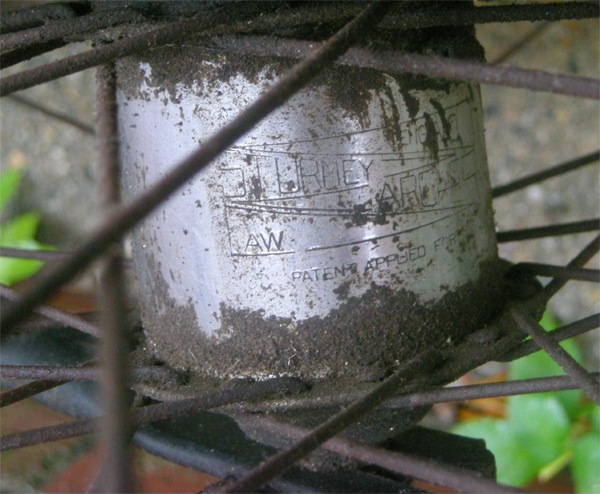 Sure, at first glance this is just another filthy Sturmey Archer hub. Those who know bicycles will see that it's an AW model, which identifies it as being from a vintage 3-speed. But look closer still. Anything unusual? If you have a good eye, you can see the words at the very bottom of the hub: "Patent applied for". Patent applied for? Why, this must be one of the earliest Sturmey Archer hubs ever made! What bicycle can it possibly belong to?
Sure, at first glance this is just another filthy Sturmey Archer hub. Those who know bicycles will see that it's an AW model, which identifies it as being from a vintage 3-speed. But look closer still. Anything unusual? If you have a good eye, you can see the words at the very bottom of the hub: "Patent applied for". Patent applied for? Why, this must be one of the earliest Sturmey Archer hubs ever made! What bicycle can it possibly belong to? Meet my "dirty little secret". She was given to me about a month and a half ago, but I kept quiet, because I am not yet certain what I will do with her. From a historical point of view, this is an amazing find: an early Raleigh Tourist in all original condition; year of production most likely 1936. This early Raleigh is the predecessor to the DL-1 Lady's Tourist I so love, but there are some notable differences between them. This early bicycle has a geometry that I find somewhat puzzling: The seat tube is quite long (almost the same size as on the 22" DL-1), but the wheelbase is extremely short, making for a crowded "cockpit" with very little room between the saddle and the handlebars. This makes the bicycle seem much too small for me, even though the saddle height is just right for my size. I would love to know the reasoning behind this construction.
Meet my "dirty little secret". She was given to me about a month and a half ago, but I kept quiet, because I am not yet certain what I will do with her. From a historical point of view, this is an amazing find: an early Raleigh Tourist in all original condition; year of production most likely 1936. This early Raleigh is the predecessor to the DL-1 Lady's Tourist I so love, but there are some notable differences between them. This early bicycle has a geometry that I find somewhat puzzling: The seat tube is quite long (almost the same size as on the 22" DL-1), but the wheelbase is extremely short, making for a crowded "cockpit" with very little room between the saddle and the handlebars. This makes the bicycle seem much too small for me, even though the saddle height is just right for my size. I would love to know the reasoning behind this construction.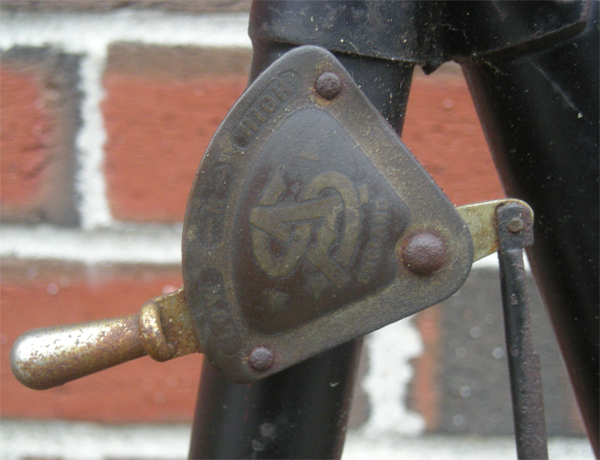 A very early Sturmey Archer 3-speed quadrant shifter. This preceded the trigger shifter that we are used to seeing on the handlebars of vintage 3-speeds. On diamond frame bicycles, the quadrant shifter was mounted on the top tube. On this bicycle it is mounted at the very top of the "loop" tube. Aside from some fading due to age, this beautiful shifter is in perfectly preserved condition. The whole bicycle, in fact, seems to be frozen in its original state, save for a coat of surface rust. The rod brakes are attached via braze-ons on the inside of the fork (as opposed to clipped on, as became the standard on later models) and function extremely well. The chrome on the handlebars and rod levers is in excellent condition.
A very early Sturmey Archer 3-speed quadrant shifter. This preceded the trigger shifter that we are used to seeing on the handlebars of vintage 3-speeds. On diamond frame bicycles, the quadrant shifter was mounted on the top tube. On this bicycle it is mounted at the very top of the "loop" tube. Aside from some fading due to age, this beautiful shifter is in perfectly preserved condition. The whole bicycle, in fact, seems to be frozen in its original state, save for a coat of surface rust. The rod brakes are attached via braze-ons on the inside of the fork (as opposed to clipped on, as became the standard on later models) and function extremely well. The chrome on the handlebars and rod levers is in excellent condition.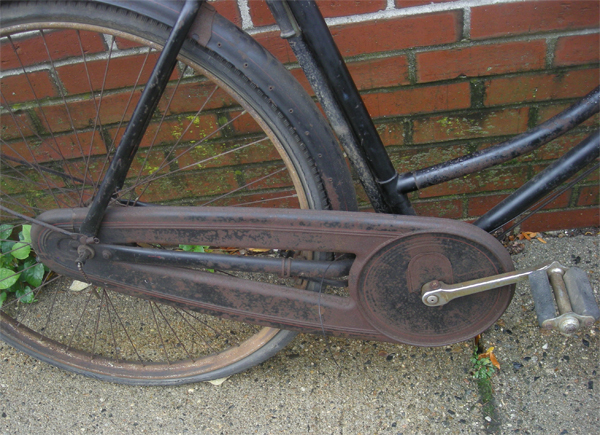 The original chaincase is entirely intact and dent-free. Notice also the holes drilled for skirtguards in the rear fender! I wonder what sort of guards this bicycle had when it was being ridden 70+ years ago.
The original chaincase is entirely intact and dent-free. Notice also the holes drilled for skirtguards in the rear fender! I wonder what sort of guards this bicycle had when it was being ridden 70+ years ago.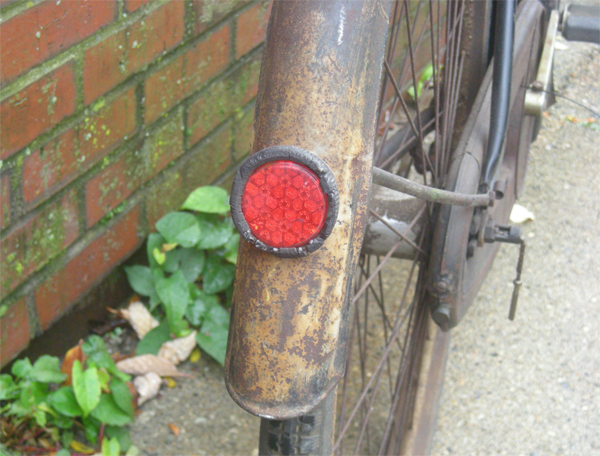 The rear reflector is glass, not plastic.
The rear reflector is glass, not plastic.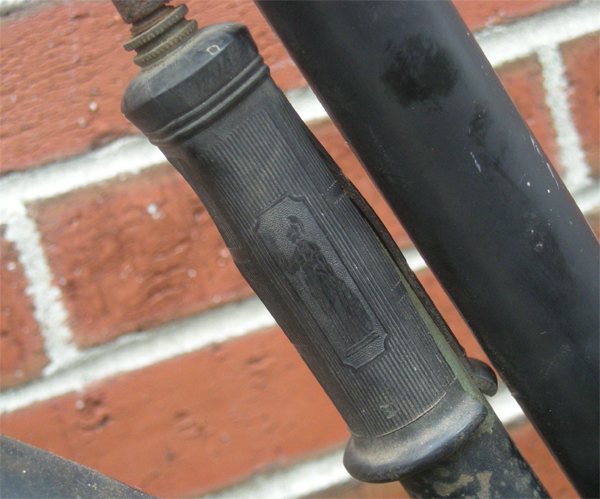 And I believe the pump is original as well, though the handle has split open. It is engraved with a Greek-themed motif. Aside from the split pump, other aspects of the bicycle that are damaged beyond repair are the melted rubber grips (see first picture) and the cracked tires. The wheels themselves look extremely rusty, but some have suggested that they might be salvageable by a soaking in an oxalic acid bath.
And I believe the pump is original as well, though the handle has split open. It is engraved with a Greek-themed motif. Aside from the split pump, other aspects of the bicycle that are damaged beyond repair are the melted rubber grips (see first picture) and the cracked tires. The wheels themselves look extremely rusty, but some have suggested that they might be salvageable by a soaking in an oxalic acid bath.The bottom line however, is that I am at a loss about this bicycle. Under the circumstances in which it was given to me, it was pretty much impossible not to take it. But I have no idea what to do with it! Even in its present state, I could probably sell it and make a bit of money, but the thought of doing that makes me sad. I could restore it and probably make quite a bit of money, but that's sad as well. Plus it looks like I will be having a very busy winter, and restoration projects might prove impossible with everything else I already have on my plate. Perhaps I should look into donating it to a museum? In the meantime, this 1930's beauty is being kindly housed by Open Bicycle. For anybody local who is interested, the bike is available for public display (but it is not for sale). Ideas for what to do with it are most welcome. Perhaps it would make a good winter bike? (I kid, I kid!)

Filigree, it is truly beautiful. That particular era had not previously moved me as it does others, but that quadrant shifter might have changed me for good. It's just stunning.
ReplyDeleteSince you open the door to advice, I'll offer some. The place this bicycle will occupy in your world may not be apparent yet, but that doesn't mean you have to rush to a resolution. A bit of time may well reveal a plan that will see this bike serving and delighting you.
Of course, I'm rooting for you to keep it. A bike like this deserves to be in informed and caring hands and yours are both.
I'm with Mike.
ReplyDeleteOne thing I'm curious about - modern three speeds usually have their gear ratios too widely spaced. However, "back in the day," some bikes had close-ratio three speeds. Might this be such a beast? That would make it doubly precious for someone riding it on fairly level terrain. You'd use second gear in calm conditions, first when riding into a headwind or starting out, and third when riding with a tailwind.
Mike - Thanks for the compliment and for the input. Ideally, I would like to eventually restore this bicycle and keep it as a collector's item in my fictional future house in the countryside. But I feel self indulgent keeping this bike around given my current situation (tiny apartment and tiny family budget). If my local bike shop did not kindly agree to host it, I would not have been able to keep it at all. My fear also is that I will end up adopting every single antique bike I see and eventually all of my friends' and local bike shop spaces will be filled with my adoptees!
ReplyDeleteSteve - afraid not. The AW is a widely spaced hub. I believe the rare and valuable closely-spaced one you are talking about is the AR. Sheldon Brown described the vintage S-A hubs very nicely here, but for some reason the site is down at the moment.
Hi Filigree, if your local bike shop can hang onto it for a bit for you, I'm sure inspiration will come your way as to what to do with it come spring and the shift into a new season. And maybe good karma will bring you the budget to restore it. It's a lovely thing, and considering its age, in wonderful condition.
ReplyDeleteGiven the strange geometry it's obviously not something you'll ride even when restored, but in your shoes I'd try to hang onto it for a bit and see what the world brings your way in terms of inspiration.
Simple. Take your time restoring it, and when you're finished, sell the newer DL1 and ride this one.
ReplyDeleteGiffen - I love my DL-1 and one would have to pry it out of my hands by force to get me to give it up. The geometry seems tailor made for me, whereas the geometry on the 1930s model is weird - As Carinthia said, it is probably not something I would ride even post restoration. I am very curious about the reasoning behind this design though.
ReplyDeleteIf it were in my possesion I would restore it.
ReplyDeleteThe wheels are 'salvageable' for I have seen someone I know well done it 'at home'. According to him , this is "possible with quality bicycles from reputable established manufacturers " ... and Raleighh is one of these few companies.
Should you decide to keep and restore this bicycle , take this bicycle for a ride after restoration and you would then 'discover' why the wheelbase is what it is. If there's anyone here who could 'discover the reason' behind this it is you for you have 'an open-and-scientific-mind' approach to problems and/or resloving them.
Regards.
:)) * ((:
Lemony.
well, if the LBS tires of hosting her, there's a dry basement in somerville that always seems to have room for *one more* bike ;-).
ReplyDeleteseriously, i wouldn't worry about coming up with a plan until the time comes that she gets her walking papers. business is slow in winter and i doubt she will be asked to leave anytime before spring. you can always think of something then... no need to decide on a restoration/preservation plan just yet.
on a slight tangent, have customers of the LBS inquired about her?
Fil, you should cross-post this over at Bike Forums! There has been a dearth of stuff about old or antique bikes, and we'd love to tear it apart.
ReplyDeleteHow beautiful!!! I am really interested to hear more about the geometry.
ReplyDeleteIs the wheelbase small, or is the angle of the head tube just more pronounced? I've ridden a Batavus Old Dutch step-through, and while it has a long wheelbase, the head tube is very long, and slanted towards the rider, which along with a long stem makes the handlebars extremely close as well, and your arms just hang straight down at your sides while sitting bolt upright. It's definitely a different feel, even from my Electra Amsterdam, but I think I could get used to it.
ReplyDeleteThat bike is amazing, really. I hope you're able to keep it and fix it up, or at least find someone who will love it.
I think Sturmey Archer actually started making internally geared hubs in 1902. They must not have felt the need to patent it until later in the game.
This old bike has amazing rod brakes. The hands that hold the rubber pads are brazed on to the inside of the frame and pivot in an elbow joint, as opposed to slotted through clip-on holds. This results in very precise engagement of the rubber pads against the inside of the rim. Basically, these 75 year old rod brakes will throw you off the saddle! It's insane how grippy they are, on par with good calipers. We haven't tested in the wet, but I wouldn't be surprised if this 1930's Tourist is off-road ready!
ReplyDeleteThe shifter alone makes me love the bike--not to mention the glass reflector!
ReplyDeleteYour local shop just may want to keep it while you decide what to do. After all, it's a conversation-starter, and if they were to put it in their window, people would stop to look at it. That can't be bad for business.
From looking at the photos, and from what I know about bikes generally, I'm guessing that the wheelbase is probably long: It would have to be in order to accomodate the tires, fenders and full chain case. However, the short top tube and long head tube seem to be designed to make the rider's position as upright as possible.
The bike, like other English roadsters, was probably designed to be ridden in the countryside, where, at that time, many of the roads were still unpaved. So most riders would want a bike that's as stable as possible. I can almost see someone hopping on, riding out to her roadside mailbox, grabbing her letters and parcels while she's still in the saddle, and riding back to her cottage.
Portlandize: Yes, S-A had been making gear hubs for decades already, but the now venerable and ubiquitous AW design was new for '36.
ReplyDeleteOddly enough, despite its success, it was also the beginning of the end for S-A, as the design compromises they made to minimize manufacturing costs is what definitively turned the sporty crowd away from hub gears and to the derailleur.
somervillain - When I first brought this bike to Open and was taking photos outside, a man pulled over in a truck and asked me where I got the bike and how much I would sell it for. I said it was not for sale, but he insisted that "everything has a price", so I said "Fine, you can have it for $1K in as-is condition". He actually considered it, but ultimately drove away. That is probably what the bike is worth in restoredcondition, though it depends on the market at the time. When it was standing on the main floor at Open, people who walked in would ask about the bike all the time, though it has since been moved to the back room for storage.
ReplyDeleteLemony - I look forward to trying the "scientific method"! For now I have pretend-ridden it and the position it places me in is like no other bike I have tried.
Re the wheelbase - Yes, I am sure that it's short; wish I had a better photo.
portlandize - Sorry, I meant specifically the AW 3-speed gear hub, which was introduced in 1936.
Justine - That image of cycling to the mailbox on an antique roadster basically sums up how I see myself living in the future!
There is no hurry to make a decision. It is being kept in a safe place where it can be admired. Its place over all scheme of things will resolve itself.
ReplyDeleteDave - I quietly posted about this on bikeforums back in October. Here is the thread (for those not bikeforum members, you need to sign in to see the full version).
ReplyDelete$1K is a 'give-away'!!!!! :0 I would have paid you for it right away!!!! :p
ReplyDeleteLemony
You could have many many years of pleasure just looking at the bicycle when it's restored! (Oooops! .. Have I "over-stepped" ?? :p )
MDI, the brakes may seem tenacious, but also remember that the rims are so rusty that the braking surface has the consistency of sand paper! in my estimation, when mated to shiny chrome plating, those same pads won't brake significantly better than any other rod brake roadster.
ReplyDeleteFiligree, you can't know that it's uncomfortable until you restore it! Hehe.
ReplyDeleteGiffen - when you're right, you're right : )
ReplyDeleteI cannot tell from the photos, Filigree- is this an"L" shaped seatpost, or a standard tube seatpost?
ReplyDeleteIn other words, is the fore-and-aft adjustment for the saddle on the post, or on the saddle itself?
I was seriously looking at a 1934 single speed Raleigh Roadster that had the "L"-shaped seatpost. It really did move the saddle forward on the frame.
(It was for sale in Texas last month.)
If that is the case, perhaps a slightly more modern post will put the saddle back a few inches, and give you a roomier cockpit. One would keep the original, of course.
On second thought, does this bike really need to be restored? After a good rub-down with wax or oil, regreased/oiled bearings, adjusted brakes, it might be ready to ride! Judging from the condition of the chaincase, all the bearings and the hub are probably in excellent condition.
ReplyDeleteAmazing!
ReplyDeleteI am no help - I like the idea of keeping it as a display for your future country home.
Hi! I love your bike! It has the same front rod brake system as my 1932´s roadster. I´ve been trying to find other frames with that kind of clamping for a while. Yours is the first I see. I am missing the right flat metal clamp on the inside of the fork that hold the front rod, and have no clue where to find a replacement. But hey, congratulations for your amazing bike, DON´t get rid of it, mine is very confortable having the same kind of geometry but in 26" men´s frame.
ReplyDeleteregards,
Hernan
I have the gents version of this bike. Mine is entirely black due to WW2. It looks like you have a brass shifter that whould polish up a treat!
ReplyDeleteI agree with Giffen - just clean, oil, adjust, maybe fit new tyres and tubes; she should be just fine. I have recently recommissioned 2 1930s BSA roadster bikes which had been parked out of use for 40+ years and both ride just fine (although the front wheel on the older of the two is a little fragile). Go for it! You'll find pics of my bikes, as well as my other interests, here:
ReplyDeletehttp://www.flickr.com/photos/16054433@N02/